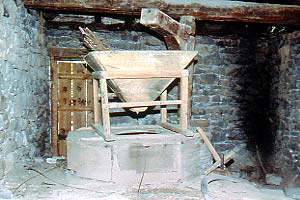
Bara

•1) From Sabiñánigo drive south to Huesca until you reach Lanave. Turn left where Boltaña is signposted. Soon the Molino de Villobas will be indicated and a bit further on the road towards Nocito. •2) You could also from Boltaña take the road to Lanave. Cross the Río Ara and a long and winding road will bring you to the Molino de Escartín. Look out now for the Nocito branch. From the point where You'll leave the main road it's 12 km of dirt road (make sure you have enough clearance!) to Nocito where Bara is signposted. •3) There is also a metalled road from the Puerto de Monrepos over Belsué to Nocito.
From Nocito 13 more kilometers of rather good gravel road lay ahead. Walk from the church down to the river (Río Alcanadre) and against the stream. Stay on the right bank.
All pictures: 05.VI.2000











